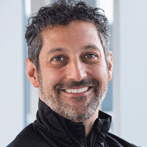Q: What has IOActive's experience in pen testing and security assessments taught you about enterprise preparedness—or the lack thereof—to deal with existing and emerging threats? Where do the biggest gaps exist?
At a very high level, our vast experience in pen testing and security assessments has taught us two important and indelible truths. First, given the pace of technology development and the subsequent threats associated with it, there will never be such a thing as being 100% secure, period. It's why we often discuss the importance of consistently balancing your efforts on defense, offense, and resilience.
That said, another important thing our experience has taught us is that the earlier you make security a priority in the design and development of your network, product, or service, the better off you will ultimately be from a security posture and preparedness standpoint. We have seen significant improvement across organizations and industries over the years as breaches have unfortunately grown to the level of notoriety that is forcing the issue, but too often we still see security being more of an afterthought, a formality needed to check the box on RFPs.
If security isn't made a top priority at the very front end, it becomes harder, more time consuming and expensive to address vulnerabilities further along the development line. So much so that the cost versus risk equation often turns sound security decisions into calculated business decisions where security is compromised. The phrase "hope is not a strategy" comes to mind when we see businesses make these decisions. As I said, it is getting better, but it's still a really big problem and the reason the cybersecurity beat is a very busy place. We don't get bored.
Q: With all the security technologies that are available these days to address virtually every conceivable threat, why do organizations need someone like an IOActive? What do you bring to the table that is so vital?
There is so much misinformation about what makes a sound security strategy. There is definitely no shortage of security technologies nowadays, but given the pace of technology and threat landscape that has emerged it's virtually impossible to cut through the noise and ensure you're staying ahead of the threats. To be clear, there are a lot of great and important security tools. I spent years with product companies and have a great appreciation for their place in building a solid security infrastructure and program.
But we consistently see organizations making massive investments in security technology and consequently developing a false sense of impenetrability, only to wind up asking how they still ended up on the receiving end of a breach. The truth is tools alone can only get you so far. To keep pace with modern threat actors you simply cannot supplant the human element. That means needing highly skilled security talent that can think like an attacker to help design better security programs and produce more secure products.
Tools can't replicate what our world-class consultants and researchers do for our clients and the industry as a whole. Threats emerge and evolve far too fast and are too complex. The real world attackers trying to exploit vulnerabilities to do bad things are human. Our experience enables us to bring that adversarial view to our work and the investments in our labs ensures our team has access to the cutting edge technologies that true adversaries do - leveling the playing field so to speak.
At our core our people are hackers. But fortunately for all of us they're on the good side and committed to making the world a safer and more secure place. I believe that attacker mind and skillset is a perspective we bring to our work and clients better than anyone in the world...and it's just not something you can buy in a box on the exhibit floor.
Q: IOActive is hosting its IOASIS event at Black Hat USA 2017. What can we expect from the event?
I'm really excited about our Vegas program this year. We're honored to be partnering with Black Hat to elevate our very popular IOAsis program and have it officially be part of arguably the industry's most influential conference. We created IOAsis to be an "escape" of sorts from the conference chaos. A place to relax, take a break, grab a bite and something to drink, network with peers, meet face-to-face with IOActive researchers, and ultimately recharge to get back out to the conference. We know there is so much to see and learn—it can be overwhelming.
In keeping with our IOAsis tradition of amazing security knowledge and talks, we'll have a great cast of our subject matter experts and researchers on hand and presenting, such as Ruben Santamarta, Lucas Lundgren, Bryan Singer, Daniel Miessler, Shane Macaulay, some of our top embedded systems lab team, and world class penetration testers. There will be an incredible knowledge base present and accessible to attendees throughout the event. IOAsis is always a great opportunity to welcome our community in to get a glimpse into their world and discuss their research, approaches to hacking, and the threats they are worried about in the years to come.
As always, our talks at the conference and IOAsis will include some great presentations, including new research on radiation monitoring devices, electronic automobile logging devices, connected motorized scooters, and more. Additionally, some of our top security pros will be covering really interesting topics, including egression testing, volatile memory analysis, emerging ICS attack models, and embedded systems hacking, iSCSI, BSD kernel vulnerabilities, forensics. I could keep going but you get the idea. It's a power-packed line-up we're bringing to town.
Looking forward to seeing everyone in Vegas!











